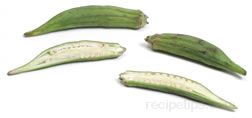Loading
Okra
A small green vegetable pods, elongated in shape, that contains numerous seeds, which release a sticky substance when cooked. Okra is commonly used as a thickener for soups and stews. It is an important ingredient in making gumbo but is also used in other dishes such as soups, stews, vegetable and meat dishes, or salads where it may be boiled, steamed, braised, sautéed, or fried. If cooked in a metal pot, it will turn black so it is best to used porcelain, oven-safe glass, clay, or an enamel sufaced pan when preparing this vegetable. Okra is most popular in Indian, Caribbean and southern US cooking. The best season for Okra is summer but it can be found in markets and stores through the fall. It is a vegetable that goes well with acidic foods, such as citrus juices, vinegar, tomatoes, and a variety of seasonings.
When selecting, look for those that are small, 2 to 3 inches long. The pods should be fresh looking, free of blemishes and firm, not mushy. Since okra does not keep well, store Okra wrapped in a paper bag in the vegetable drawer of the refrigerator where it can be stored for 1 to 2 days.
USDA Nutrition Facts | |||||||||||||||||||||||||||||||||||||||||||||||||||||||||||||||
|
|||||||||||||||||||||||||||||||||||||||||||||||||||||||||||||||
There currently aren't any reviews or comments for this term. Be the first!
Advertisement
Advertisement










